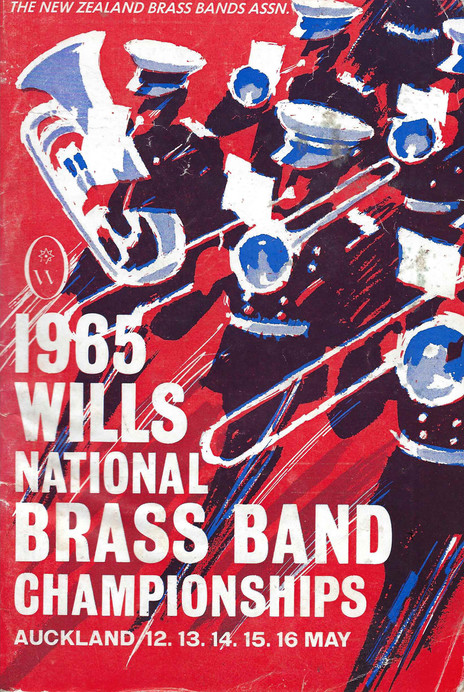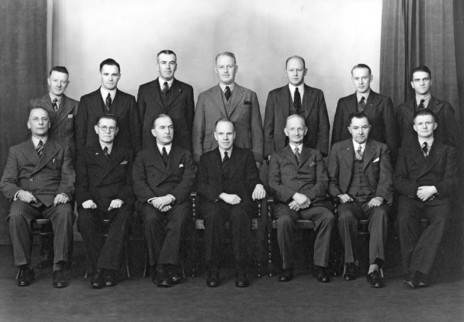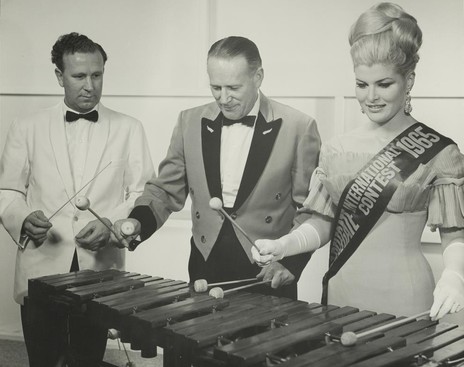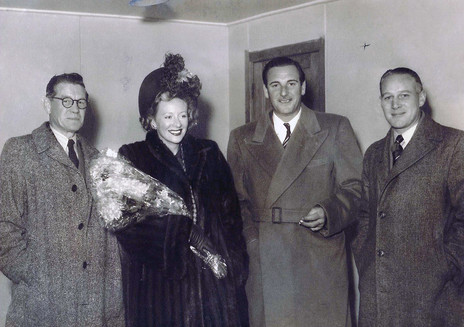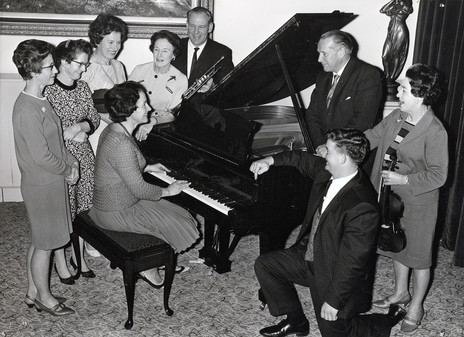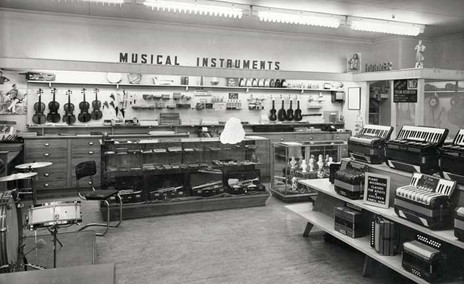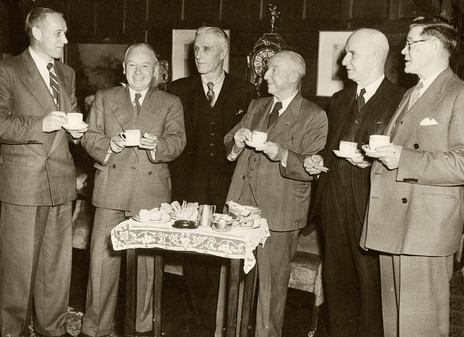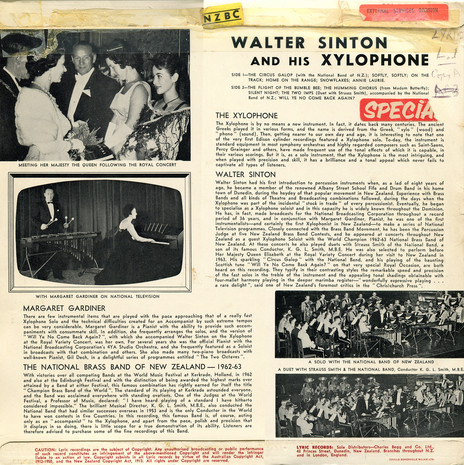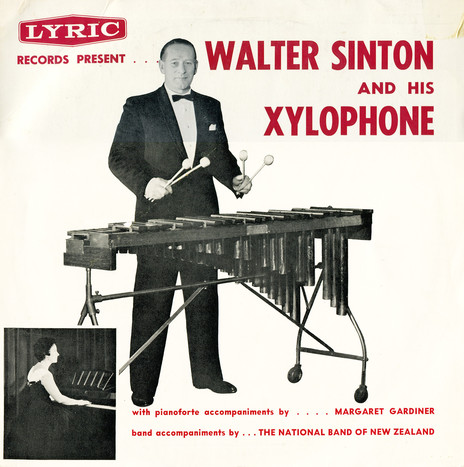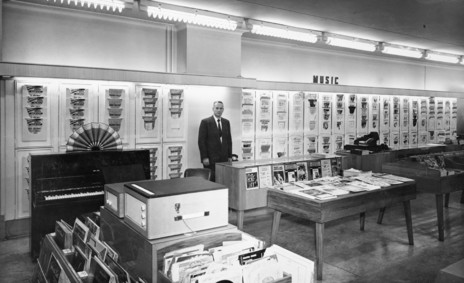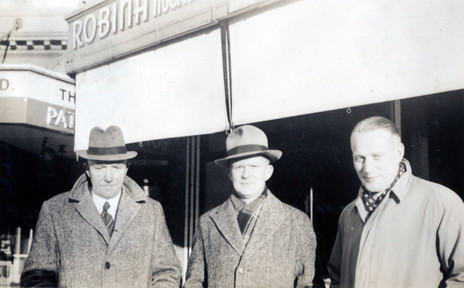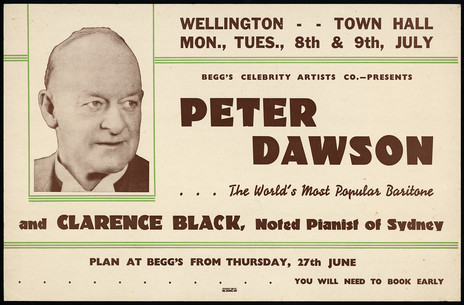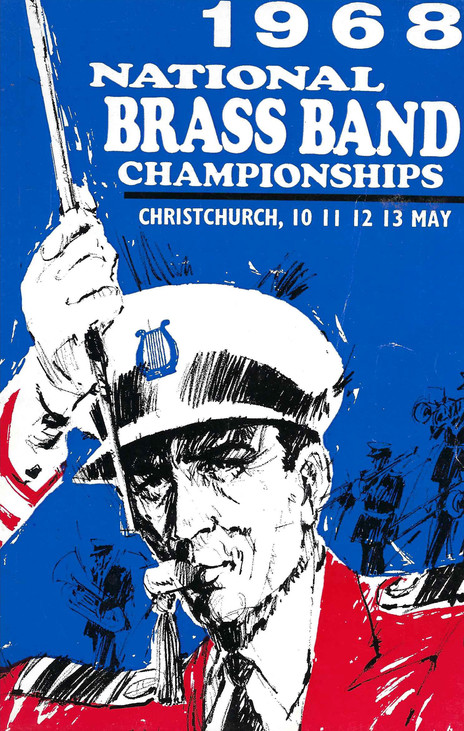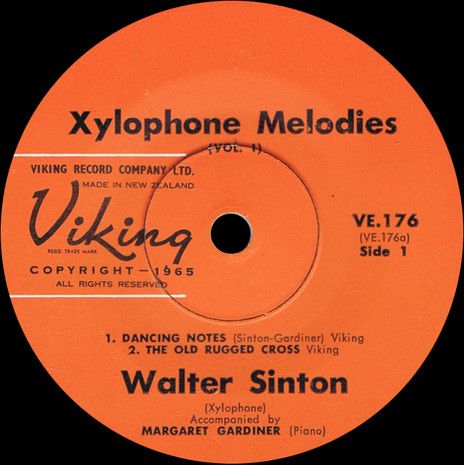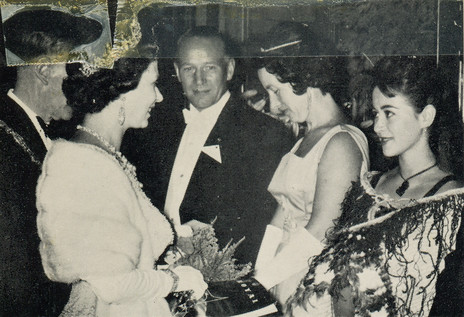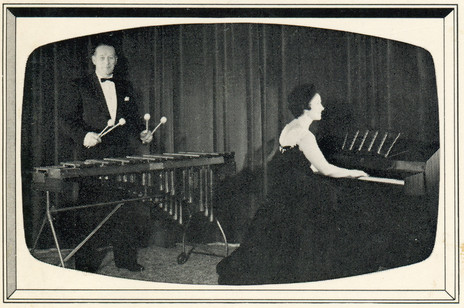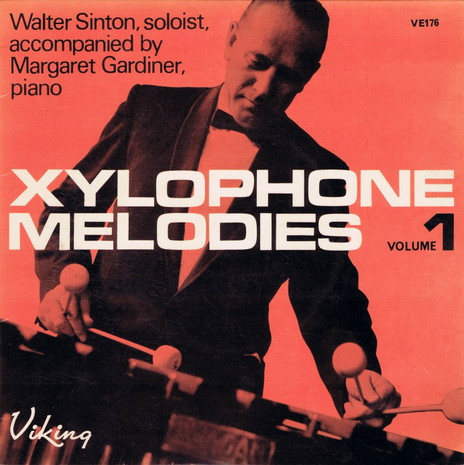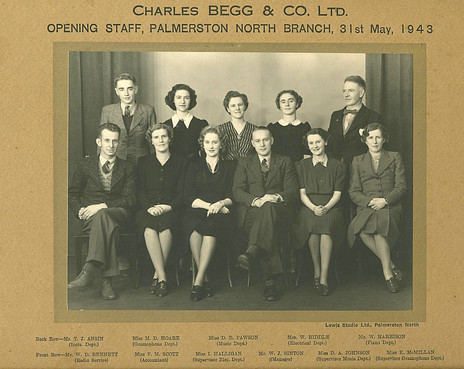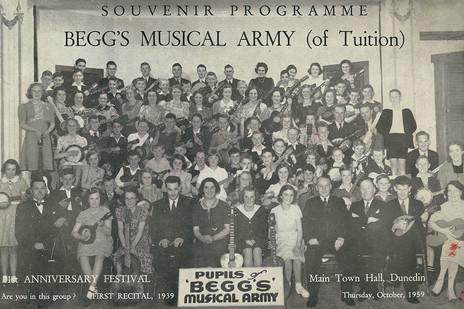Sinton, whom the Evening Star labelled “the wizard of the xylophone” when he was 31, was born in Dunedin in 1911. His father was a butcher and Sinton began his musical career when he was only four, hitting a kerosene tin drum with a pair of meat skewers in the Albany Street School fife-and-drum band. The headmaster conducted and trained the players in the band where Wally quickly moved from skewers to sticks and from tin to side drum. He carried on drumming throughout his school years and after leaving Otago Boys’ High School joined the Kaikorai Brass Band as percussionist; he was part of the band for many years. Playing a brass instrument never appealed to him: “I was used to playing with sticks.”
Sinton first broadcast as a xylophone soloist in 1927.
At the highly successful South Seas Exhibition in Dunedin from 1925 to 1926, music was very important. During the exhibition Sinton played the side drum in Les Napier’s Trumpet and Bugle Band (regarded as the best of its kind in the Commonwealth), the Third Artillery Combination, and the visiting Argyll and Sutherland Highlanders Band. He also regularly drummed in Dunedin theatres for travelling and local shows. Pit drummers were expected to play other percussion instruments in addition to drums, and Sinton chose to concentrate on the xylophone and make it his specialty. He liked the xylophone as it had a “brilliant and also a deep organ-like sound”.
Sinton’s broadcasting career as a xylophone soloist began in 1927, and in 1977 he celebrated his 50th anniversary of broadcasting (mostly on Dunedin’s 4YA) by recording a jubilee programme in the same studio where his first recording had taken place. Looking back over 50 years of recording, he remembered the formality of the early days in the recording studio with men in dinner suits and women in evening dress. The event was, he said, “much like a party in the home”.
Recording in the early days was much more stressful then, as transmission was live and there were no second chances. In a 1970 interview Sinton remembered many early radio personalities including Madam Reggiardo who, along with her students, used to record frequently and at the end of each night would say to anyone who had performed, “You were wonderful, how did I sound?”
Sinton also recorded with several dance bands. One of these, led by well-known band leader Dick Colvin, recorded both at the Savoy while playing on a Friday night, and in the studio. For some years he was also a member of the Novelettes trio with Alf Pettit (piano) and Muriel Caddie (piano accordion) and played with many other groups, including Monsieur de Rose’s orchestra.
Sinton and the pianist Margaret Gardiner had a performing partnership for many years and together they made dozens of broadcasts and recordings. He recorded with His Master’s Voice, Viking, and Decca, and around 1951 when Tanza took its primitive tape machine to Dunedin he played the vibraphone on a recording with The Tumbleweeds. He was one of the first instrumentalists in New Zealand to present a series of programmes on television.
Prominent in the brass band movement, Sinton frequently performed with the 4th Regimental (Red Coats) Military Band. He toured New Zealand with many National Brass Bands and overseas with the National Band tours of 1962, 1965 and 1967, playing the xylophone and thus adding variety to the band’s repertoire. During the 1962 tour he played duets with the band’s conductor, K G L Smith.
Sinton performed in front of the Queen AS PART OF A ROYAL VARIETY CONCERT in Dunedin in 1963.
Known as a witty and entertaining raconteur, as well as touring with the National Bands, Sinton also compered many of their performances. In 1966 Sinton was selected for the New Zealand National Band’s tour of North America where He appeared in more than 98 theatres in America and Canada, including performing at the Hollywood Bowl where he played a solo hymn, ‘Nearer My God to Thee’.
As part of the royal tour of 1963 Dunedin hosted a Royal Variety Concert, and Sinton – in what he considered the highlight of his career – performed in front of the Queen, firstly with the National Band and then with Margaret Gardiner.
Sinton was also an arranger and composer. He started arranging xylophone solos in his 30s. Initially he based his transcriptions and arrangements on recordings he’d heard, largely those from the US and in particular the recordings of George Hamilton Green, an American xylophonist. Later he turned to composing, recording one of his pieces, ‘Xylophonics’, with the National Band.
Sinton wrote and judged percussion test pieces at most New Zealand band contests for more than 25 years. His composition output was not restricted to music for the xylophone and other percussion. He was the composer of a musical, Coffee and conversation: a musical play in two acts, the libretto of which is held by the Alexander Turnbull Library, although the musical score has been lost.
Music occupied his working and leisure hours. After leaving school he worked for 10 years in his father’s butchery shop in Albany Street, next door to where he had grown up. Many years later he recounted that his father had been a very tough boss and “it took me five years to stop running after I left my father” but that working for his father had given him “a determination to work hard”. In 1936 he left his father’s employ and joined the music business of Charles Begg & Co as a radio salesman, finding the two sides of his musical life nicely complemented each other.
Selling proved a natural metier and after a time selling radios, he moved to Begg’s musical instrument department. In 1941 he was promoted to Timaru as branch manager and in 1943 he moved to Palmerston North to open a Begg’s branch there. He returned to Dunedin later that year to work as assistant to the general manager, Eric Begg.
Combined with this role Sinton became the manager of Begg’s Celebrity Artists’ Company, when it was formed in 1946, and was responsible for bringing a number of overseas artists to New Zealand. Greek soprano Angela Parselles, pianist Lettie Keyes, UK singing duo Anne Ziegler and Webster Booth), and Australian baritone Peter Dawson all toured New Zealand between 1946 and 1949 under his management. The tours were extensive and those of Peter Dawson and Anne Zeigler and Webster Booth were particularly popular. Apart from their musical performances Peter Dawson’s down-to-earth approach had wide appeal and Anne Zeigler’s sumptuous crinolines were a wonderful antidote to austerity in post-war New Zealand. (Ziegler and Booth later released a recording of ‘Blue Smoke’.)
While publishing Begg’s collections of Māori songs, Sinton decided to learn te reo.
In 1952 he was appointed manager of Begg’s Dunedin branch and when the branches were sold in 1971 he purchased and continued to run the Dunedin shop, which he did until his death in 1980. A sartorial dresser, when interviewing a prospective employee Sinton took the state of an individual’s shoes into account as an indicator of his or her suitability.
Another aspect of his role as assistant to the general manager was to negotiate contracts for the many pieces of music Begg’s published. While involved in publishing Begg’s collections of Māori songs, Sinton – an individual of wide and varied interests – became interested in the Māori language and decided to learn te reo.
Walter Sinton’s musical activities extended beyond percussion and brass bands and he was a well-known man about town in the Edinburgh of the South. For a time president of the Dunedin Operatic Society, in 1964 he was behind the creation of the Dunedin Civic Orchestra. His keen interest in Dunedin, Otago and its musical and theatrical life led him to pen a series of articles for the Evening Star on the history of theatre and music in Dunedin. Published in the 1970s, these articles continue to be a great resource for anyone researching music, theatre or the social and cultural history of New Zealand and Dunedin in particular. He was also a keen sportsman and Rotarian.
